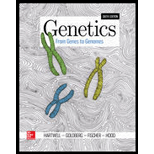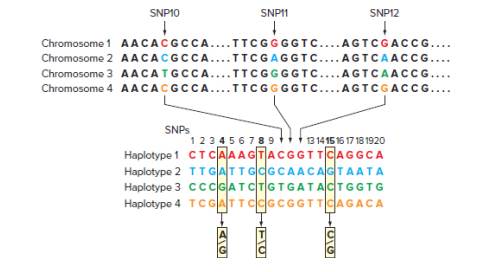
Concept explainers
In GWAS analysis, because of the existence of LD blocks (or haplotype blocks), it is not necessary to genotype a person for every one of the 50 million known SNPs. Haplotype blocks are stretches of DNA containing particular SNP variants that tend to be inherited together (as a block) because recombination within the region is rare. In the accompanying figure, three different SNP loci are shown at top (SNP10, SNP11, and SNP12), each with two alleles among the world’s population of humans.

Only four of all the possible combinations of these SNP alleles are found in human genomes, as shown in the four chromosome types pictured. These three SNPs are part of a larger block of 20 SNPs that are usually inherited in one of the four configurations, or haplotypes, shown. Because these 20 SNPs are inherited as haplotype blocks, genotyping any individual for the three so-called Tag SNPs (SNP4, SNP8, and SNP15 shown in bold) should be sufficient to predict that individual’s alleles for the other 17 SNPs.
| a. | How many configurations of the three SNPs shown at the top of the diagram (SNPs 10, 11, and 12) are theoretically possible? |
| b. | How many haplotype variants are theoretically possible considering all 20 SNPs in the haplotype block, and assuming that each of them has two possible alleles? |
| c. | Given that humans are diploid, every individual has two copies of every (autosomal) haplotype block, one on each homolog. Does heterozygosity for the haplotype blocks interfere with genotyping individuals using the Tag SNPs shown in the diagram? Explain? |
| d. | In part (c), you saw that the three Tag SNPs shown in the diagram are sufficient to type any individual for this particular haplotype block. Is this the only set of three Tag SNPs that could be used? |
Want to see the full answer?
Check out a sample textbook solution
Chapter 22 Solutions
Genetics: From Genes To Genomes (6th International Edition)
Additional Science Textbook Solutions
Biological Science (6th Edition)
Genetics: From Genes to Genomes
Applications and Investigations in Earth Science (9th Edition)
Campbell Essential Biology (7th Edition)
HUMAN ANATOMY
Biology: Life on Earth with Physiology (11th Edition)
- Which of the following is not true about the life-cycle of Fucus. a. 8 eggs per oogonium b. 64 sperm per antheridium c. eggs are flagellated d. sperm are flagellatedarrow_forwardGreen Algae, as a group, is actually paraphyletic with one subgroup more closely related to higher plants than the other. Which of the following green algae groups is more closely related to higher plants: a. Charophyceans b. Chlorophyceans c. Rhodophyta d. Xanthophyceansarrow_forwardCertain toxic terpenoids in this group is thought to deter herbivory but may also have some anti-tumor activity? a. green algae b. brown algae c. red algae d. golden algae e. none of thesearrow_forward
- In the cellular slime molds, the most common phase is: a. plasmodium b. pseudoplasmodial c. single cells as myxamoebae d. moundingarrow_forwardWhich of the following descriptive terms does not describe Hydrodictyon? a. colonial b. nonmotile c. 1 large reticulated chloroplast in each cell d. all of these describe Hydrodictyonarrow_forwardWhich of the following does not apply to Chara? a. "stoneworts" b. isogamous c. calcified walls d. apical growth with an axis and branchesarrow_forward
 Human Heredity: Principles and Issues (MindTap Co...BiologyISBN:9781305251052Author:Michael CummingsPublisher:Cengage Learning
Human Heredity: Principles and Issues (MindTap Co...BiologyISBN:9781305251052Author:Michael CummingsPublisher:Cengage Learning Biology: The Dynamic Science (MindTap Course List)BiologyISBN:9781305389892Author:Peter J. Russell, Paul E. Hertz, Beverly McMillanPublisher:Cengage LearningCase Studies In Health Information ManagementBiologyISBN:9781337676908Author:SCHNERINGPublisher:Cengage
Biology: The Dynamic Science (MindTap Course List)BiologyISBN:9781305389892Author:Peter J. Russell, Paul E. Hertz, Beverly McMillanPublisher:Cengage LearningCase Studies In Health Information ManagementBiologyISBN:9781337676908Author:SCHNERINGPublisher:Cengage
 Concepts of BiologyBiologyISBN:9781938168116Author:Samantha Fowler, Rebecca Roush, James WisePublisher:OpenStax College
Concepts of BiologyBiologyISBN:9781938168116Author:Samantha Fowler, Rebecca Roush, James WisePublisher:OpenStax College





